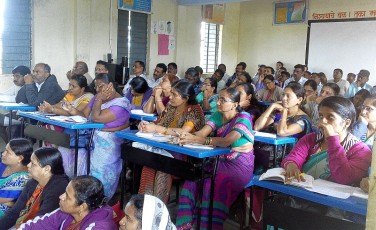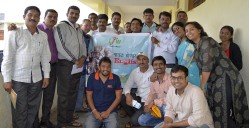The Place : Maval taluka comes in the Maval subdivision of Pune district of state of Maharashtra in India.
The Work : The objective of this project is to demonstrate a possibility of making an entire geography (Maval Taluka comprises of 181 villages) English literate and also evolve a well-documented model for achieving this goal.
Good intentions and efforts can always do with the right push at the right time. And in our case, the right push was in the form of Mr. Kale, the Block Development Officer of Maval taluka. He was perturbed at the shrinking number of Zilla Parishad schools in the region and felt that competition with English medium schools was one of the prime reasons for the decline. And believed that if we there was an easy method whereby the teachers could easily teach their students then the ZP schools would stand a chance against the private English schools. (Read the blog post).
 This is where he saw merit in our English Literacy Program (ELP) and felt the need to implement it across Maval. Once we got the Block Development Officer’s nod to go ahead with making Maval English-literate, we decided to achieve our objective by working with the largest segment of teachers, viz., the Govt. School Teachers (Zilla Parishad school teachers) (Read the blog post).
This is where he saw merit in our English Literacy Program (ELP) and felt the need to implement it across Maval. Once we got the Block Development Officer’s nod to go ahead with making Maval English-literate, we decided to achieve our objective by working with the largest segment of teachers, viz., the Govt. School Teachers (Zilla Parishad school teachers) (Read the blog post).
 809 ZP teachers from 289 schools spread over 24 Kendras in the taluka were trained (Read the blog post) for the first two levels of ELP. The training was completed by end of September 2016 (Read the blog post).
809 ZP teachers from 289 schools spread over 24 Kendras in the taluka were trained (Read the blog post) for the first two levels of ELP. The training was completed by end of September 2016 (Read the blog post).
The deployment of the ELP had begun across Maval. IVR (Interactive Voice Response system) calls made on a weekly basis gave us an idea of the extent of progress and if in case, individual teachers were having queries or seeking clarifications their queries were attended to. Soon it was time to conduct tests as assessment was not only a necessary part of our Program but essential for all the stakeholders to know where they stood (Read the blog post). But the sheer logistics needed called for a different method of assessment. That is when we weighed the pros and cons of the OMR (optical mark recognition) method of assessment. Popularly used in surveys, tests and questionnaires, this method would expedite the process of feeding the data and getting the analysis done. This seemed to be a good solution when it came to scaling up our work and handle large number of test papers coming in regularly for assessment.
 The first OMR test (which was our Ground Level Reading Test #3) was taken but not before a great deal of planning had taken place especially wrt the collection and distribution of papers. In our next posts, shall write about our experience and learning from this whole assessment exercise as well as share feedback from the teachers themselves. As it shall stand in good stead for anyone looking to making a whole geography, English-literate.
The first OMR test (which was our Ground Level Reading Test #3) was taken but not before a great deal of planning had taken place especially wrt the collection and distribution of papers. In our next posts, shall write about our experience and learning from this whole assessment exercise as well as share feedback from the teachers themselves. As it shall stand in good stead for anyone looking to making a whole geography, English-literate.

